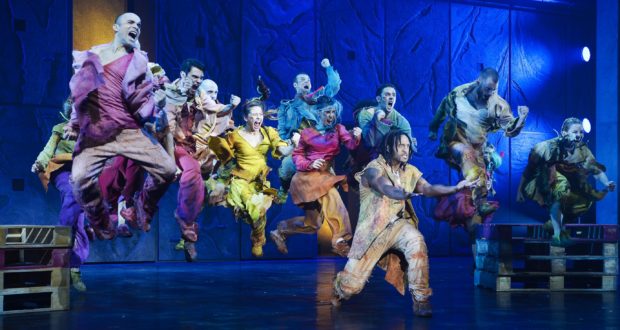Pros: Nicely menacing Gothic atmosphere.
Cons: Shallow characterisation and a complete lack of variation in tone
Never knowingly understatedSummary
Rating
Good
A word of warning to anyone planning a visit to Notre Dame de Paris at London Coliseum. Brace yourself. Brace for histrionics. The breast-beating starts early, with the first big number, Les Sans-papiers, and never really lets up for the rest of the show. The understandable anguish of the outcasts, the vulnerable and the falsely accused is rendered with the same power ballad intensity as the rather less justified anguish of those thwarted in lust. So it’s quite a ride.
Act I is frustrating; all exposition, with very little in the way of narrative drive or characterisation. A number of different questions are set up: will the hordes at the gate receive asylum? Will Esmeralda succumb to Phoebus? Who will emerge successful from the somewhat sinister love heptagon? It’s hard to care, because none of the characters has more than one dimension. The sung-through form doesn’t help, with every situation, every backstory, every emotion having to be explained in two minutes of song, rather than elucidated more naturalistically. Act II is a considerable improvement. Here, situations arise which demand a resolution, there is a degree of suspense and genuinely moving moments, as when Quasimodo sings Dieu que le monde est injuste and Danse mon Esmeralda.
Alongside the principals there is a large cast of impressive dancers, acrobats and breakdancers. They light up the big ensemble pieces where, for example, the outcasts lay siege to the gates of the Cité, gather together for the Feast of Fools, or are kettled by Phoebus and his troops. There are astonishing gymnastic sequences, with inventive use of wheeled barricades, beds, pallets and the versatile set. The costumes and choreography work together to create an impression of riotous anarchy which makes a pleasant counterpoint to the brooding menace of Frollo and his cathedral. There are, however, plenty of scenes where everything could be stripped back, and where the dancing, acrobatics and moving parts create unnecessary distraction, without being integral to the context. Two notable exceptions are the accompaniments to Les cloches and Danse mon Esmeralda. In the former, three acrobats make the bells of Notre Dame their playground, in the latter an aerial dance starts off looking distinctly unpromising, but lands just the right side of tasteless, and indeed becomes rather beautiful.
The set and lighting design are a large part of what makes this show enjoyable. Notre Dame is a grey and forbidding wall looming over the rest of the stage, but its camouflaged handles and flying buttresses make it a climbing frame for nimble Cité dwellers. Projections, shadows, silhouettes and all manner of lighting effects are employed, in the ‘more is more’ spirit of this show, which in this case is probably correct – the Ile de la Cité is rendered ghostly but magnificent.
In their rather bombastic programme, the producers wonder whether we will “find new relevance in [the show], echoing the current events of today.” Well the answer is a resounding ‘yes’. There is the all-too-recognisable trope of the powerful and vindictive sexual predator, and there is also the certainty that Clopin and his fellow travellers would have understood the term ‘citizen of nowhere’. The show does convey, not only through the story of the asylum-seekers but also through Quasimodo himself, the despair and grief of wanting to belong, wanting to be accepted, but being judged only by your ‘otherness’. I wonder how it played to any of the many French people in the audience being made to apply for ‘settled status’.
So, if you’re heading for Notre Dame de Paris looking for subtlety or complexity, you may be disappointed. If you’re after spectacle and a good dose of melodrama, then you’re absolutely in luck!
Author: Adapted from Victor Hugo by Luc Plamondon and Richard Cocciante
Director: Gilles Maheu
Choreographer: Martino Müller
Booking until: 27 January 2019
 Everything Theatre Reviews, interviews and news for theatre lovers, London and beyond
Everything Theatre Reviews, interviews and news for theatre lovers, London and beyond



